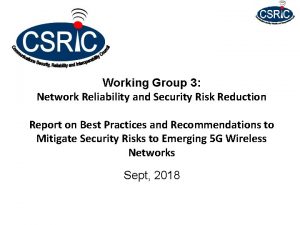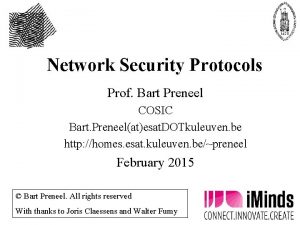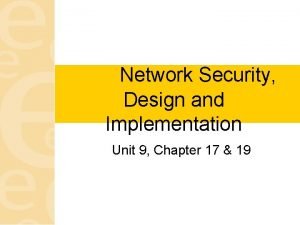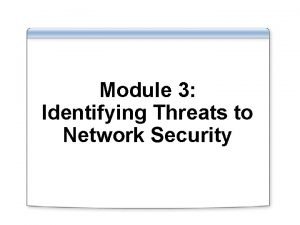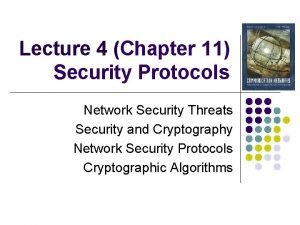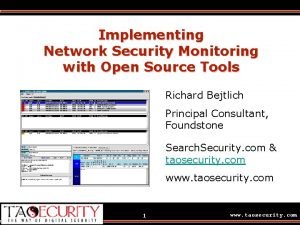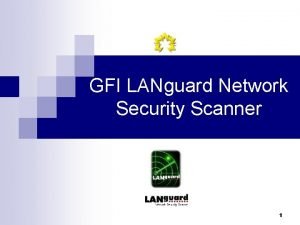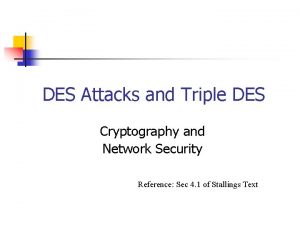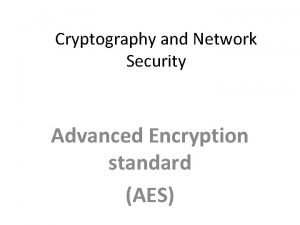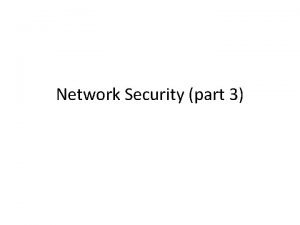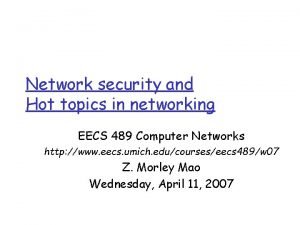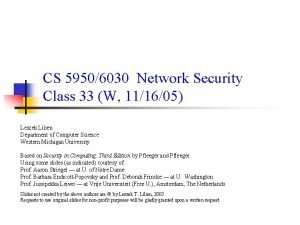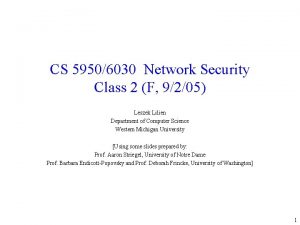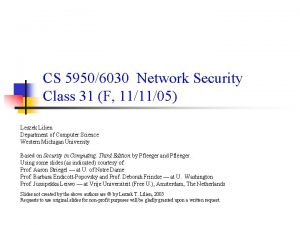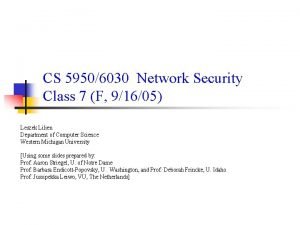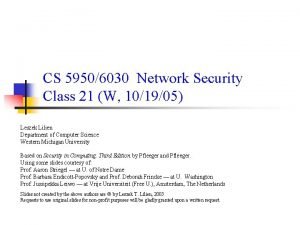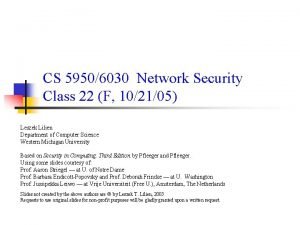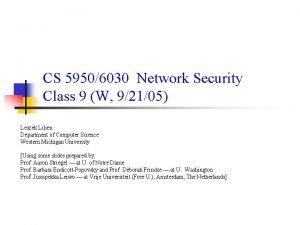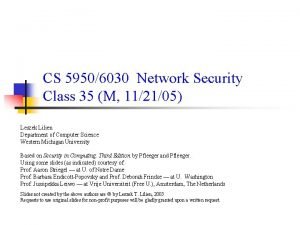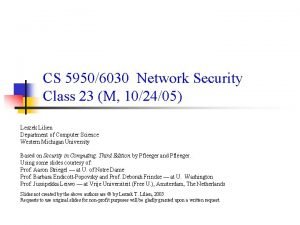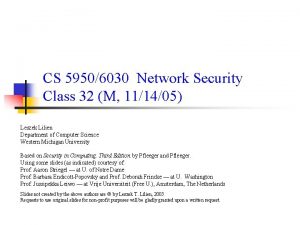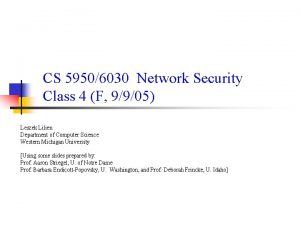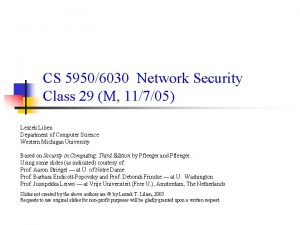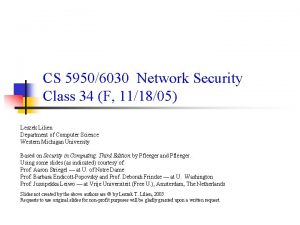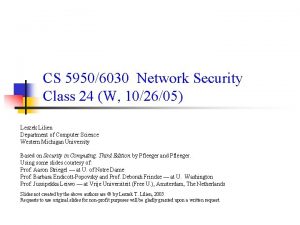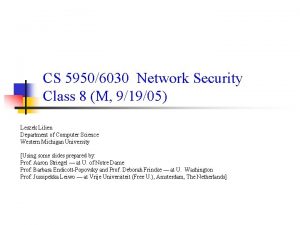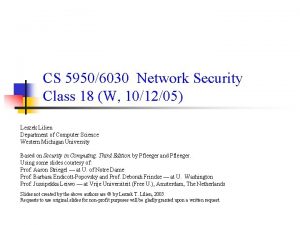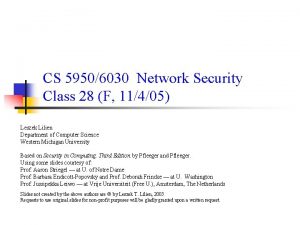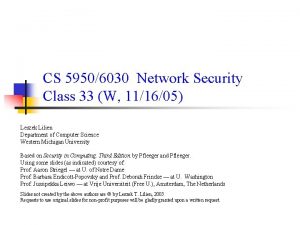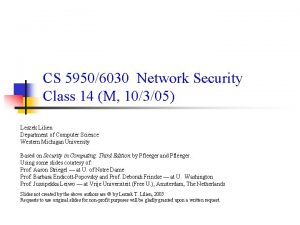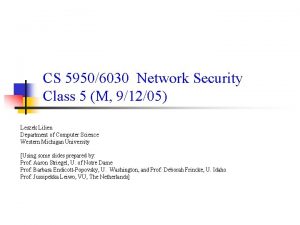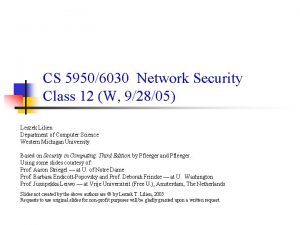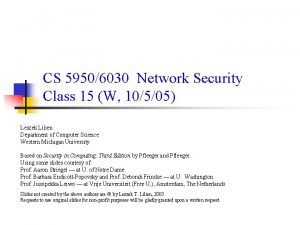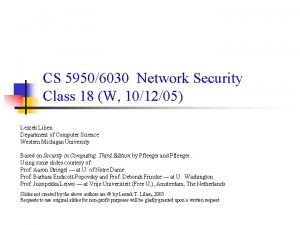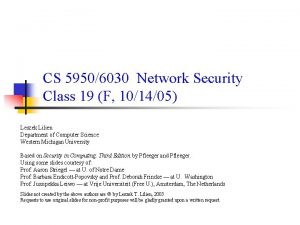CS 59506030 Network Security Class 27 W 11205

































- Slides: 33

CS 5950/6030 Network Security Class 27 (W, 11/2/05) Leszek Lilien Department of Computer Science Western Michigan University Based on Security in Computing. Third Edition by Pfleeger and Pfleeger. Using some slides courtesy of: Prof. Aaron Striegel — at U. of Notre Dame Prof. Barbara Endicott-Popovsky and Prof. Deborah Frincke — at U. Washington Prof. Jussipekka Leiwo — at Vrije Universiteit (Free U. ), Amsterdam, The Netherlands Slides not created by the above authors are © by Leszek T. Lilien, 2005 Requests to use original slides for non-profit purposes will be gladly granted upon a written request.

7. Security in Networks 7. 1. Network Concepts. . . Class 7. 2. Threats in Networks a) Introduction 26 b) c) d) e) 2 Network vulnerabilities Who attacks networks? Threat precursors Threats in transit: eavesdropping and wiretapping

7. 2. Threats in Networks (1) § Outline a) b) c) d) e) Introduction Network vulnerabilities Who attacks networks? Threat precursors Threats in transit: eavesdropping and wiretapping . . . 3

b. Network vulnerabilities (1) § Network characteristics significantly increase security risks § These vulnerability-causing characteristics include: 1) Attacker anonymity § Attacker can be far away § Can disguise attack origin (pass through long chain of hosts) § Weak link: computer-to-computer authentication 2) Many points of origin and target for attacks § Data and interactions pass through many systems on their way between user and her server § Each system can be origin of an attack or target for attack § 4 Systems might have widely different security policies/mechanisms

c. Who attacks networks? (1) § Who are the attackers? § We don’t have a name list § Who the attackers might be? § MOM will help to answer this § § 5 MOM = Method/Opportunity/Motives of attackers: 1) Challenge/Power 2) Fame 3) Money/Espionage 4) Ideology

d. Threat precursors (1) n n n 6 How attackers prepare for attacks? n Investigate and plan These are threat prescursors If we detect threat precursors, we might be able to block attacks before they’re launched Threat prescursors techniques include: 1) Port scan 2) Social engineering 3) Reconnaissance 4) OS and application fingerprinting 5) Using bulletin boards and chats 6) Getting available documentation

e. Threats in transit: eavesdropping and wiretapping (1) § Threats to data in transit: 1) Eavesdropping 2) Wiretapping a) Passive wiretapping b) Active wiretapping – injecting msgs Wiretapping technique depends on the communication medium § 7 covered: cable, microwave, satellite, optical fiber, wireless

Class 26 ended here 8

7. Security in Networks. . . Class 7. 2. Threats in Networks a) Introduction 26 b) c) d) e) Class 27 9 f) g) Network vulnerabilities Who attacks networks? Threat precursors Threats in transit: eavesdropping and wiretapping Protocol flaws Types of attacks 1) Impersonation 2) Spoofing 3) Message confidentiality threats 4) Message integrity threats 5) Web site attacks

7. 2. Threats in Networks (1) § 10 Outline a) b) c) d) e) Introduction Network vulnerabilities Who attacks networks? Threat precursors Threats in transit: eavesdropping and wiretapping f) Protocol flaws g) Types of attacks 1) Impersonation 2) Spoofing 3) Message confidentiality threats 4) Message integrity threats 5) Web site attacks 6) Denial of service (attack on availability) 7) Distributed denial of service (attack on availability) 8) Threats to active or mobile code 9) Complex attacks h) Summary of network vulnerabilities

f. Protocol flaws n 11 Protocol flaws: n Design flaws n Proposed Internet protocols posted for public scrutiny n Does not prevent protocol design flaws n Implementaion flaws

g. Types of attacks g-1. Impersonation (1) n n n 12 Impersonation = attacker foils authentication and assumes identity of a valid entity in a communication Impersonation attack may be easier than wiretapping Types of impersonation attacks (IA): 1) IA by guessing 2) IA by eavesdropping/wiretaping 3) IA by circumventing authentication 4) IA by using lack of authentication 5) IA by exploiting well-known authentication 6) IA by exploiting trusted authentication

Impersonation (2) 1) Impersonation attacks by guessing n Ways of guessing: n Common word/dictionary attacks n Guessing default ID-password pairs n n n Guessing weak passwords Guessing can be helped by social engg n E. g. , guess which account might be dead/dormant n n 13 E. g. , GUEST-guest / GUEST-null / ADMIN-password Read in a college newspaper online that Prof. Ramamoorthy is on sabbatical => guessses that his acct is dromant Social engg: call to help desk to reset password to one given by attacker

Impersonation (3) 2) Impersonation attacks by eavesdropping/wiretaping n User-to-host or host-to-host authentication must not transmit password in the clear n Instead, e. g. , transfer hash of a password n Correct protocols needed n Devil is in the details n Example of simple error: Microsoft LAN Manager n 14 -char password of 67 characters n Divided into 2 pieces of 7 chars for transmission n Each piece hashed separately n To break hash, wiretapper need at most: 677 + 677 = 2 * 677 attempts n Should have divided into 2 pieces for transmission after hashing, not before (hash 14 not 2 * 7 chrs) => would have 6714 possibilities 14

Impersonation (4) 3) Impersonation attacks by circumventing authentication n Weak/flawed authentication allows bypassing it n „Classic” OS flaw: n Buffer overflow caused bypassing password comparison n Considered it correct authentication! n Crackers routinely scan networks for OSs with weak/flawed authentication n 15 Share this knowledge with each other

Impersonation (5) 4) Impersonation attacks by using lack of authentication a) Lack of authorization by design n Example: Unix facilitates host-to-host connection by users already authorized on their primary host n. rhosts - list of trusted hosts n. rlogin - list of trusted users allowed access w/o authentication n Attacker who gained proper id I 1 on one host H 1, can access all hosts that trust H 1 (have H 1 and I 1 in . rhosts and. rlogin, respectively) b) Lack of authorization due to administrative decision n n E. g. , a bank may give access to public information to anybody under guest-no login account-pasword pair „Guest” account can be a foothold for attacker n 16 Attacker will try to expand guest privileges to exploit the system

Impersonation (6) 5) Impersonation attacks by exploiting well-known authentication n Example: A computer manufacturer planned to use same login-password pair for maintenance account for any of its computers all over the world n System/network admins often leave default password unchanged n n Example: „community string” deafult password in SNMP protocol (for remote mgmt of network devices) Some vendors still ship computers with one sys admin account installed with a default password 6) Impersonation attacks by exploiting trusted authentication n Identification delegated to trusted source n E. g. , on Unix with. rhosts/. rlogin (see 4 a above) n Each delegation is a potential security hole! 17 n Can you really trust the „trusted” source?

g-2. Spoofing (1) Spoofing — attacker (or attacker’s agent) pretends to be a valid entity without foiling authentication n n Spoof - 1. To deceive. [. . . ] The American Heritage® Dictionary of the English Language: Fourth Edition. 2000 n n 18 Don’t confuse spoofing with impersonation n Impersonation — attacker foils authentication and assumes identity of a valid entity Three types of spoofing: 1) Masquerading 2) Session hijacking 3) Man-in-the middle (MITM)

Spoofing (2) 1) Masquerading = a host pretends to be another n Really: attacker sets up the host (host is attacker’s agent) n Masquerading - Example 1: n Real web site: Blue-Bank. com for Blue Bank Corp. n Attacker puts a masquerading host at: Blue. Bank. com n n n A mistyping user (who just missed „-”) is asked to login, to give password => sensitive info disclosure Can get users to masquerading site by other means n n 19 It mimics the look of original site as closely as possible E. g. , advertise masquerading host with banners on other web sites (banners would just say „Blue Bank”-no „-” there) Similar typical masquerades: n xyz. org and xyz. net masquerade as xyz. com n 10 pht. com masquerades as lopht. com n citicar. com masquerades as citycar. com

Spoofing (3) n Masquerading - Example 2: n Attacker exploits web server flaw – modifies web pages n Makes no visible changes but „steals” customers n E. g. , Books-R-Us web site could be changed in a sneaky way: n Processing of browsing customers remains unchanged BUT n Processing of ordering customers modified: (some) orders sent to competing Books Depot n 20 Only „some” to mask the masquerade

Spoofing (4) 2) Session hijacking = attacker intercepting and carrying on a session begun by a legitimate entity n n Session hijacking - Example 1 n Books Depot wiretaps network and intercepts packets n After buyer finds a book she wants at Books-R-Us and starts ordering it, the order is taken over by Books Depot Session hijacking - Example 2 n Sysadmin starts Telnet session by remotely logging in to his privileged acct n Attacker uses hijacking utility to intrude in the session n n 21 Can send his own commands between admin’s commands System treats commands as coming from sysadmin

Spoofing (5) 3) Man-in-the middle (MITM) n Similar to hijacking n Difference: MITM participates in a session from its start (session hijacking occurs after session established) . . . continued. . 22

Spoofing (6) MITM – Example: Alice sends encrypted msg to Bob (a) Correct communication n Alice requests key distributor for KPUB-Bob n Key distributor sends KPUB-Bob to Alice n Alice encrypts P: C = E (P, KPUB-Bob ) & sends C to Bob n Bob receives C and decrypts it: P = D (C, KPRIV-Bob ) n (b) MITM attack n Alice requests key distributor for KPUB-Bob n MITM intercepts request & sends KPUB-MITM to Alice n Alice encr. P: C = E (P, KPUB-MITM ) & sends C to Bob n MITM intercepts C & decrypts it: P = D (C, KPRIV-MITM ) n MITM requests key distributor for KPUB-Bob n Key distributor sends KPUB-Bob to MITM n MITM encr. P: C = E (P, KPUB-Bob ) & sends C to Bob n Bob receives C and decrypts it: P = D (C, KPRIV-Bob ) Note: Neither Alice not Bob know about MITM attack 23

g-3. Message confidentiality threats (1) n Message confidentiality threats include: 1) Eavesdropping – above 2) Impersonation – above 3) Misdelivery n Msg delivered to a wrong person due to: n Network flaw n Human error n Email addresses should not be cryptic iwalkey@org. com better than iw@org. com iwalker@org. com better than 10064, 30652@org. com 24

Message confidentiality threats (2) 4) Exposure n Msg can be exposed at any moment between its creation and disposal n Some points of msg exposure: n n Many ways of msg exposure: n n 25 Temporary buffers Switches / routers / gateways / intermediate hosts Workspaces of processes that build / format / present msg (including OS and app pgms) Passive wiretapping Interception by impersonator at source / in transit / at destination 5) Traffic flow analysis n Mere existence of msg (even if content unknown) can reveal sth important n E. g. , heavy msg traffic form one node in a military network might indicate it’s headquarters

g-4. Message integrity threats (1) Message integrity threats include: 1) Msg fabrication 2) Noise n 1) Msg fabrication n Receiver of fabricated msg may be misled to do what msg requests or demands n 26 Some types of msg fabrication: n Changing part of/entire msg body n Completely replacing whole msg (body & header) n Replay old msg n Combine pieces of old msgs n Change apparent msg source n Destroy/delete msg

Message integrity threats (2) n Means of msg fabrication: n Active wiretap n Trojan horse n Impersonation n Taking over host/workstation 2) Noise = unintentional interference n Noise can distort msg n Communication protocols designed to detect/correct transmission errors n 27 Corrected by: n error correcting codes n retransmission

g-5. Web site attacks (1) n Web site attacks – quite common due to: n Visibility n n E. g. , web site defacement – changing web site appearance Ease of attack n Web site code available to attacker (Menu: View>>Source) n A lot of vulnerabilities in web server s/w n n 28 E. g. , 17 security patches for MS web server s/w, IIS v. 4. 0 in 18 months Common Web site attacks: 1) Buffer overflows 2) Dot-dot attacks 3) Exploiting application code errors 4) Server-side include

Web site attacks (2) 1) Buffer overflows n Attacker feeds pgm much more data than it expects (as discussed) n iishack - best known web server buffer overflow problem n 29 Procedure executing this attack is available

Web site attacks (3) 2) Dot-dot attacks n In Unix & Windows: ‘. . ’ points to parent directory n Example attack: on webhits. dll for MS Index Server n Pass the following URL to the server http: //URL/null. htw? Ci. Web. Hits. File=/. . /winnt/system 32/autoexec. nt n n n Returns autoexec. nt file – attacker can modify it Other example attacks: Lab Manual – p. 257 n Using. . %255 c. . in URL allows executing arbitrary commands Solution to (some) dot-dot attacks: 1) Have no editors, xterm, telnet, utilities on web server => no s/w to be executed by an attacker on web server to help him 2) Create a fence confining web server 30

Web site attacks (4) 3) Exploiting application code errors n Source of problem: n Web server may have k*1, 000 transactions at a time n Might use parameter fields (appended to URL) to keep track of transaction status n Example: exploiting incomplete mediation in app (cf. earlier) § URL generated by client’s browser to access web server, e. g. : http: //www. things. com/order/final&cust. ID=101&part=555 A&qy=20&price=10&ship=boat&shipcost=5&total=205 § Instead, user edits URL directly, changing price and total cost as follows: http: //www. things. com/order/final&cust. ID=101&part=555 A&qy=20&price=1&ship=boat&shipcost=5&total=25 § User sends forged URL to web server § The server takes 25 as the total cost 31

Web site attacks (5) 4) Server-side include n HTML code for web page can contain include commands n n n 32 Example n Open telnet session from server (with server’s privileges) n <!-#exec cmd=/”usr/bin/telnet &”-> include exex (# exec) commands can be used to execute an arbitrary file on the server Attacker can execute, e. g. , commands such as: n chmod – changes access rights n sh – establish command shell n cat – copy to a file

End of Class 27 33
 Private secuirty
Private secuirty What is the osi security architecture
What is the osi security architecture Security guide to network security fundamentals
Security guide to network security fundamentals Wireless security in cryptography and network security
Wireless security in cryptography and network security Electronic mail security in network security
Electronic mail security in network security Security guide to network security fundamentals
Security guide to network security fundamentals Security guide to network security fundamentals
Security guide to network security fundamentals Visa international security model in information security
Visa international security model in information security Nstissc model
Nstissc model E commerce security meaning
E commerce security meaning Seven touchpoints for software security
Seven touchpoints for software security Network reliability and security
Network reliability and security Wlan network
Wlan network Palo alto certified network security engineer
Palo alto certified network security engineer Network security protocols
Network security protocols Network security essentials 5th edition pdf
Network security essentials 5th edition pdf Three classes of intruders in network security
Three classes of intruders in network security Network security design and implementation
Network security design and implementation Module 3: information and network security
Module 3: information and network security Cipher based message authentication code
Cipher based message authentication code Network security protocols
Network security protocols Nsm network security monitoring open systems
Nsm network security monitoring open systems Gfi languard network scanner
Gfi languard network scanner Des in networking
Des in networking Cryptography and network security 6th edition
Cryptography and network security 6th edition Introduction to network security and cryptography
Introduction to network security and cryptography Number theory in network security
Number theory in network security Firewall in cryptography and network security
Firewall in cryptography and network security Authentication in cryptography and network security
Authentication in cryptography and network security Aes in network security
Aes in network security Modern network security threats
Modern network security threats Remote network security services
Remote network security services Network security topologies
Network security topologies Interesting topics in network security
Interesting topics in network security











